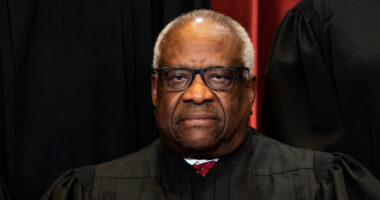
President Donald Trump departs after signing an executive order at an event to announce new tariffs in the Rose Garden of the White House, Wednesday, April 2, 2025, in Washington (AP Photo/Evan Vucci).
A Texas judge on Friday gave the Trump administration a victory in an Alien Enemies Act (AEA) case by denying several immigrant detainees the ability to litigate their claims as a class, or collectively.
In a 48-page order, U.S. District Judge James Hendrix, who was appointed by President Donald Trump during his first term, found the three petitioners were simply too “distinct” and “diverse” — in terms of facts, claims, and potential remedies — to make up a coherent class.
The underlying litigation is one of many AEA cases directly tracing its lineage to the U.S. Supreme Court’s blockbuster April 7 ruling, which dissolved a nationwide injunction barring summary deportations under the auspices of the obscure 18th-century wartime law. Simultaneously, the nine justices agreed the government could not use the AEA without due process and prescribed the use of habeas corpus petitions.
Hendrix, in his order, is ever mindful of the Supreme Court’s guidance. The judge goes so far as to stay the effect of his ruling until the detainees have the opportunity to seek and receive — or be denied — consideration at the highest level.
Love true crime? Sign up for our newsletter, The Law&Crime Docket, to get the latest real-life crime stories delivered right to your inbox.
While not necessarily a setback for the detained immigrants who are currently parties to the litigation, the district court’s order frustrates the American Civil Liberties Union’s efforts to litigate on behalf of any other potential detainees “who were, are, or will be” under the AEA deportation dragnet in the sprawling Northern District of Texas.
For now, however, the court agreed with a government filing arguing the petitioners lack “commonality and typicality” required under the relevant rule of civil procedure that governs class certification.
“The petitioners bring many independent claims driven by individual circumstances, rendering them atypical from potential class members,” the order goes on. “Moreover, the petitioners’ varying circumstances prevent them from satisfying Rule 23(b)(2)’s uniformity-of-relief requirement.”
In the class certification request, the petitioners “focus almost exclusively” on the argument that Trump’s AEA proclamation “is invalid,” the order notes. While such an argument provides a notable measure of harmony throughout the would-be class, Hendrix says it’s insufficient.
“[T]he Court cannot assume that this argument will prevail and ignore the several additional claims,” Hendrix explains. “And those claims are highly individualized and would prove unworkable as a class due to atypicality.”
The judge delineates how this might play out, at length:
[W]hile the three petitioners have filed asylum applications, the Court has no way of knowing how many putative class members have pending asylum applications or intend to file asylum applications. This distinction is material. If the petitioners do not prevail on their first claim regarding the President’s Proclamation, but do prevail on their third claim for relief regarding the application of the INA’s asylum provisions, then the due process required for members of the class would differ depending on whether the member of the putative class seeks to file or has already filed an asylum application.
In other words, the court envisions a scenario where asylum claims protect some people contesting an AEA designation, while the asylum theory of protection might not even be available to others.
The judge goes through each of the petitioners’ various other claims, aside from asylum, and points out in each instance that the relevant inquiries require an assessment of facts. Such assessments, the court says, weigh against finding typicality among detainees.
In fact, Hendrix says the claimed violations of habeas “may present the most individualized claims in this case” altogether and show “there will likely be no meaningful similarity among class members.”
“The petition shows that the respondents have different evidence and theories for why each petitioner is a member of TdA, and the respondents will need to present particularized evidence for each detainee to determine their citizenship, age, and affiliation with the TdA,” the judge notes. “No petitioner is typical for these highly individualized arguments, yet these arguments may very well turn out to be dispositive. And as the Supreme Court has explained, habeas is the core of these proceedings, so it would be unusual to permit atypical petitioners to seek classwide representation.”
But the judge goes even beyond the rules of civil procedure to rubbish the idea of class certification, saying he would oppose the effort in any event as a matter of judicial “discretion.”
Hendrix explains his reasoning as being both in line with the high court’s ruling, as well as an issue of efficiency and fairness.
“[T]he Court today makes clear that cases in this Court will proceed as members of the Supreme Court suggested — individual habeas petitions filed in district courts,” the order goes on. “The Court is accustomed to a voluminous docket and has committed to resolving these individual cases with the balance of speed and care that they require, allowing individual detainees to decide whether to file habeas petitions and how they wish to proceed with their petitions.”
The judge offers an example to underscore this point:
For example, perhaps an individual currently in custody has a strong factual defense against deportation even if they were subject to the Proclamation and the AEA procedures were entirely appropriate. Consider, for example, a petitioner who is a citizen or only thirteen years old. That petitioner may seek to have the Court assume without deciding that the Proclamation is valid, sidestepping the complicated claims presented in this putative class petition and instead pursue an immediate hearing on the simple fact of their citizenship or age. In the event of a mandatory class, the petitioner may be forced to wait for these more complicated issues to be resolved. And if another interlocutory appeal took place in this case, those issues not strictly necessary to the resolution of this hypothetical petitioner’s claim would be further delayed.
“[H]abeas is important and personal, and individuals should get the opportunity to decide whether they wish to file habeas petitions and how to pursue their liberty,” Hendrix says.
For now, the detained immigrants in the case are still protected from summary deportations, due to an exceedingly atypical April 19 ruling from the Supreme Court. In that ruling, the justices ordered the government “not to remove” the immigrants “until further order.”











